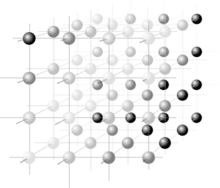
Back فوكسل Arabic Voksel Azerbaijani Воксел Bulgarian Vòxel Catalan Voxel Czech Voxel Danish Voxel German Vóxel Spanish واکسل Persian Vokseli Finnish


 |
| Part of a series on |
| Video game graphics |
|---|
A voxel is a three-dimensional counterpart to a pixel. It represents a value on a regular grid in a three-dimensional space. Voxels are frequently used in the visualization and analysis of medical and scientific data (e.g. geographic information systems (GIS)).[1] They are also commonly used in video games, both as a technological feature, as in Outcast, and a graphical style, which was popularised by Minecraft.[2]
As with pixels in a 2D bitmap, voxels themselves do not typically have their position (i.e. coordinates) explicitly encoded with their values. Instead, rendering systems infer the position of a voxel based upon its position relative to other voxels (i.e., its position in the data structure that makes up a single volumetric image). Some volumetric displays use voxels to describe their resolution. For example, a cubic volumetric display might be able to show 512×512×512 (or about 134 million) voxels.
In contrast to pixels and voxels, polygons are often explicitly represented by the coordinates of their vertices (as points). A direct consequence of this difference is that polygons can efficiently represent simple 3D structures with much empty or homogeneously filled space, while voxels excel at representing regularly sampled spaces that are non-homogeneously filled.
One of the definitions is:
Voxel is an image of a three-dimensional space region limited by given sizes, which has its own nodal point coordinates in an accepted coordinate system, its own form, its own state parameter that indicates its belonging to some modeled object, and has properties of modeled region.
This definition has the following advantage. If fixed voxel form is used within the whole model it is much easier to operate with voxel nodal points (i.e. three coordinates of this point). Yet, there is the simple form of record: indexes of the elements in the model set (i.e. integer coordinates). Model set elements in this case are state parameters, indicating voxel belonging to the modeled object or its separate parts, including their surfaces.[3]
- ^ Chmielewski, Sz., Tompalski, P. (2017). "Estimating outdoor advertising media visibility with voxel-based approach". Applied Geography, 87:1–13 doi:10.1016/j.apgeog.2017.07.007. Preprint download: "Estimating outdoor advertising media visibility with voxel-based approach (PDF Download Available)". Archived from the original on 2017-10-02. Retrieved 2017-10-02.
- ^ Sprinks, Harry Ted (16 August 2023). "10 Games To Play If You Love Voxel Graphics". Game Rant. Retrieved 27 November 2024.
- ^ Shchurova, Catherine I. (2015). "A methodology to design a 3D graphic editor for micro-modeling of fiber-reinforced composite parts". Advances in Engineering Software. 90. Advances in Engineering Software Volume 90, December 2015, Pages 76-82: 76–82. doi:10.1016/j.advengsoft.2015.07.001.